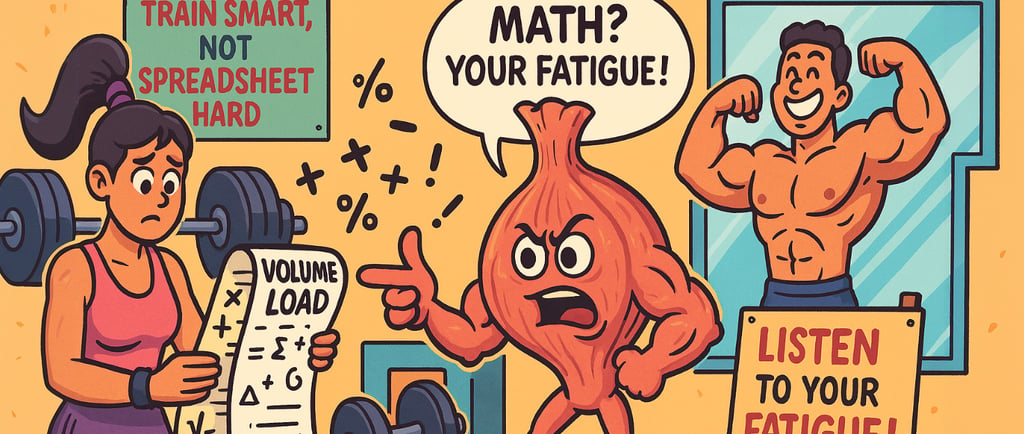How can we stop pretending that counting sets and reps gives us the full picture of how tough a workout actually is?
Traditional ways of measuring training load in resistance training -you know, sets × reps × weight or "volume-load"-, are about as helpful as a chocolate teapot when it comes to understanding what’s really going on in your muscles. Welcome muscle fatigue kinetics, or how your muscles actually get knackered over time.
ENGLISHFITNESSSTRENGTH
JM Benavides
4/6/20253 min read


So, you're smashing your gym sessions, logging reps like your spreadsheet holds the secrets of the universe, chugging protein shakes like it's holy water... and still, nothing. Nada. Zip. Your gains? Missing. Your energy? Somewhere between a damp sock and last week’s leftovers. What gives? Well, guess what... you've been lied to.
Let me introduce you to the latest scientific slap across the face from the fine folks in white coats over at the University of Montpellier. Yes, the French. Known for wine, cheese, and now for blowing up the BS around how we measure training.
Volume-Load or Volume-Flawed?
You’ve probably heard of this magic formula until it makes you sicker that a set of chin-ups to failure:
Volume Load = Sets x Reps x Weight.
Simple. Clean. Utter nonsense, according to this paper. That equation is supposed to help you track your training intensity and fatigue. Except it doesn’t. Why? Because your muscles don’t give two protein shakes about your spreadsheet. They care about TIME-UNDER-TENSION. They care about how hard they had to work, not how much you lifted.
The sacred cow formula of gym bros and sis, the default for trainers who never question anything post-2005… Problem? It’s as outdated as your uncle’s cargo shorts. Because what your muscles care about is how long they’re suffering, not just how many kilos you stack on the bar like Lego bricks to impress the room. The body doesn’t react to what’s on your whiteboard, it reacts to stress, fatigue, and how much pain your quads whisper to your soul by rep #X.
Let’s not go mental, either. According to this study, volume-load might be a decent guesstimate, but it’s about as useful as a chocolate foam roller.
Let’s Talk RFD: Rate of Freakin’ Decay
Here’s where it gets spicy. The researchers used something called Rate of Force Development (RFD), fancy speak for "how fast your muscles can go full beast mode before they tap out." They did this to monitor how muscles were losing their mojo over the course of different training intensities. Basically, they found:
Low-intensity, high-rep: Your muscles are basically tortured by boredom and endless effort. Think slow death by pink dumbbells.
High-intensity, low-rep: Boom. Done. Sharp and painful like stubbing your toe on a kettlebell.
Moderate intensity: The sweet spot. Your muscles hate you, but they hate you just the right amount.
In other words: different roads, same burnout. But your typical volume-load calc? Totally blind to it all.
Fatigue is Queen. And She’s Not on Your App.
This paper drops the mic by proposing something different: measuring load based on actual muscle fatigue. Not sets, not rep, just how quickly your power fizzles out like a cheap firework. Best part? You don’t need a sci-fi lab. Some decently nerdy gear and a willingness to listen to your muscles cry is enough. Instead, track the decline in explosiveness. That’s where the truth lives.
Now that’s something worth logging.
So, What’s the Takeaway for the Rest of Us Mere Mortals?
If you’re training like a beast but recovering like a slug, it might be time to stop chasing volume for volume’s sake.
Let’s break it down bar-stool style:
If you’re wrecked after every session but can’t open a pickle jar two days later, something is not right.
Stop chasing volume like it’s a mythical dragon of gainz. It’s not. Just a decoy.
Ask better questions:
Am I training smart, or just beating myself into submission?
Am I recovering like a pro, or dragging myself through each workout like a sweaty zombie?
There’s a difference between hard work and smart work. And let’s be honest, half of Instagram’s fitness advice belongs in the garden shed along with your forgotten plank board and the resistance band you used once.
Bottom Line?
Stop worshipping volume-load gurus like they own the holy grail. Instead, tune into what your muscles are actually telling you. Fatigue is the real MVP here. Listen to it. Measure it. Respect it.
That response isn’t always visible in numbers. Listen to your fatigue. Respect your effort. Ditch the spreadsheet and start thinking like a muscle, not a calculator. And maybe, just maybe, you’ll stop spinning your wheels and start lifting like you mean it.
So next time your pals tell you they did 5x10 at 70%, ask them how their RFD held up. Watch them blink and picture their synapses collapse. Sip your coffee. Walk away prouder (no smug face required).
Now, go forth and educate your gym bros and sis. And for heaven’s sake, ditch the flipping spreadsheet.
For more information: Imbach, F., Perrey, S., Brioche, T., & Candau, R. (2025). A muscle physiology-based framework for quantifying training load in resistance exercises. Sports, 13(1), 13.
Copyright © 2021-25. All rights reserved.
All images created with the assistance of the AI
Our Network
IA te Digo https://iatedigo.es




